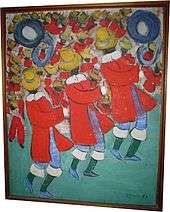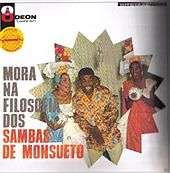Monsueto
| Monsueto Menezes | |
|---|---|
| Birth name | Monsueto Campos de Menezes |
| Also known as | Monsueto |
| Born |
November 4, 1924 Morro do Pinto favela, Rio de Janeiro, Brazil |
| Origin | Rio de Janeiro |
| Died |
March 17, 1973 (aged 48) Rio de Janeiro |
| Genres | Samba |
| Occupation(s) | Musician, singer, composer, painter, actor |
| Instruments | Voice, drums |
Monsueto Campos de Menezes (November 4, 1924 – March 17, 1973), better known as Monsueto, was a Brazilian sambista, singer, composer, drummer, painter, and actor. He was a part of the samba de morro (Portuguese for "hill samba") school, and helped popularize it along with other artists such as Cartola, Nelson Cavaquinho, Clementina de Jesus, Silas de Oliveira, Mano Décio da Viola, and Zé Keti.[1] His musical output, though small, is considered very valuable to the history of Brazilian music.[2]
Career

Born in Gávea but raised in the favela Morro do Pinto, Monsueto was an orphan by the age of three and was brought up by his grandmother and aunt. He began playing drums around the age of 15, and during the 1940s he played in various bands, including the Orquestra de Copinha, which performed at the Copacabana Palace Hotel. During the early 1950s many of his compositions were recorded by other artists, and by the late 1950s he was appearing in films and on television, and making his own recordings. In later years, he found success as a painter.[3]
Influence
After waning in popularity, Monsueto was "rediscovered" in the late 1960s, beginning with Maria Bethânia's cover of his song "Mora na filosofia". Two legendary albums recorded in the 1970s (Milton Nascimento et al.'s Clube da Esquina and Caetano Veloso's Transa, voted to number 7 and number 10, respectively, on Rolling Stone Brazil's list of greatest Brazilian albums of all time[4]) featured Monsueto's compositions. Caetano performed a rock and roll-inspired version of the song his sister had previously covered, "Mora no filosofia", on Transa,[5] while Milton performed "Me deixa em paz" with Alaíde Costa on Clube da Esquina. Caetano also performed Monsueto's song "Eu quero essa mulher" on Araçá azul, the followup to Transa.
Filmography
- O Forte (1974)
- A Hora e a Vez do Samba (1971)
- Salário Mínimo (1970)
- Of Gods and the Undead (1970)
- Quatro Homens Juntos (1965)
- La leona (1964)
- The Golden Goddess of Rio Beni (uncredited) (1964)
- Briga, Mulher e Samba (1960)
- Favela (1960)
- Na Corda Bamba (1958)
- Treze Cadeiras (1957)
Discography
78 singles

- O sucesso está na cara/Larga o meu pé (Monsueto, 1964)
- Chica da Silva/Mané João (Odeon, 1963)
- Sambamba/Retrato de Cabral (Orion, 1963)
- Ajudai o próximo/Eu quero essa mulher assim mesmo (Odeon, 1961)
- Prova real/Bola branca (Copacabana, 1957)
- Nega Pompéia/Q. G. do samba (Mocambo, 1955)
LPs
- Mora na Filosofia dos Sambas de Monsueto (Odeon, 1962)
References
- ↑ McGowan, Chris; Pessanha, Ricardo (1998). "Chapter Two". The Brazilian sound: samba, bossa nova, and the popular music of Brazil (illustrated ed.). Philadelphia: Temple University Press. p. 33. ISBN 9781566395458. Retrieved 2012-02-22.
- ↑ Cravo Albin, Ricardo (1997). "A magia do rádio, seus mitos e a guerra dos auditórios". MPB: a história de um século (in Portuguese, Spanish, and English) (illustrated ed.). Rio de Janeiro: Fundação Nacional de Arte. p. 296. ISBN 8585781386. Retrieved 2012-02-22.
- ↑ "Monsueto" (in Portuguese). Dicionário Cravo Albin da Música Popular Brasileira. Retrieved 2012-02-22.
- ↑ "Os 100 maiores discos da música brasileira" (in Portuguese). Umas Linhas. December 20, 2007. Retrieved 2009-04-20.
- ↑ Veloso, Caetano; translated by Isabel de Sena (2002). Tropical Truth. New York: Knopf. p. 350. ISBN 0-375-40788-X.
External links
- Monsueto at the Internet Movie Database
- Monsueto at the AllMusic Guide